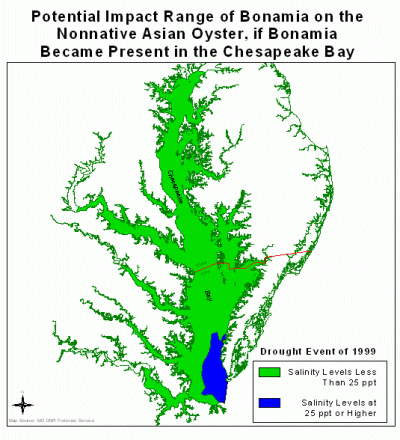
ANNAPOLIS — Maryland and Virginia officials yesterday announced that recent reports by the news media suggesting that Maryland and Virginia’s proposal to introduce the non-native Asian oyster (Crassostrea ariakensis) could fail because of mortalities associated with the oyster parasite, Bonamia sp. are overstated, and based upon incomplete data and analyses.
"While Bonamia is not currently known to be in the Chesapeake Bay, experiments are still being conducted to refine estimates of the salinity tolerance of the Bonamia species that infects C. ariakensis,” said Eugene M. Burreson, Professor, Virginia Institute of Marine Science (VIMS). “Our research suggests that if Bonamia became present in the Bay, the impact would be likely limited to the lower portions of the Bay.”
Since January 2004, the State of Maryland, the Commonwealth of Virginia, and the Army Corps of Engineers have been preparing an environmental impact statement (EIS) to evaluate current options for the restoration of oysters in the Chesapeake Bay. The EIS is a study to evaluate the ecological, economic and cultural risks and benefits associated with native and nonnative oyster restoration alternatives. One of the risks being evaluated by this study is how diseases, including Bonamia, affect native and non-native oysters.
The following is a summary of the scientific findings to date of the Bonamia disease:
* Concerns about the potential impacts of the Bonamia disease on the proposed introduction of C. ariakensis into the Chesapeake Bay began in 2003 when scientists determined that a Bonamia sp. was responsible for the significant mortalities observed in the C. ariakensis being field tested in Bogue Sound, North Carolina.
* Since this discovery was made in North Carolina, the Virginia Institute of Marine Science has implemented a comprehensive research program directed at evaluating the potential impacts of the Bonamia disease in the Chesapeake Bay.
* Over the past ten years, scientists have conducted controlled field experiments using sterile C. ariakensis throughout the Chesapeake Bay, and have yet to discover the Bonamia disease in the Chesapeake Bay.
* If Maryland and/or Virginia decide to go forward with an introduction of C. ariakensis into the Chesapeake Bay, strict international protocols for introducing nonnative marine species would prevent C. ariakensis from introducing the Bonamia disease into the Bay.
* If a Bonamia sp. became established in the Chesapeake Bay through another carrier, field and lab data suggest that Bonamia disease may be restricted to high salinity areas (>25 ppt). The limitation of low to intermediate salinities on this infection would limit the impact of the disease on C. ariakensis in many areas of the Chesapeake Bay, including the majority of areas where oysters exist within Maryland waters.
* Research indicates that smaller oysters (~1.5 inches) are more susceptible to Bonamia disease than larger oysters.
* There is no evidence that the Bonamia disease causes mortality in the Bay’s native oyster (C. virginica).
A comprehensive evaluation of the risks associated with Bonamia disease, as well as the other risks surrounding the potential introduction of C. ariakensis will be made available to the public through a draft EIS that is scheduled to be available during 2007.
Source: Md. Department of Natural Resources (DNR)


